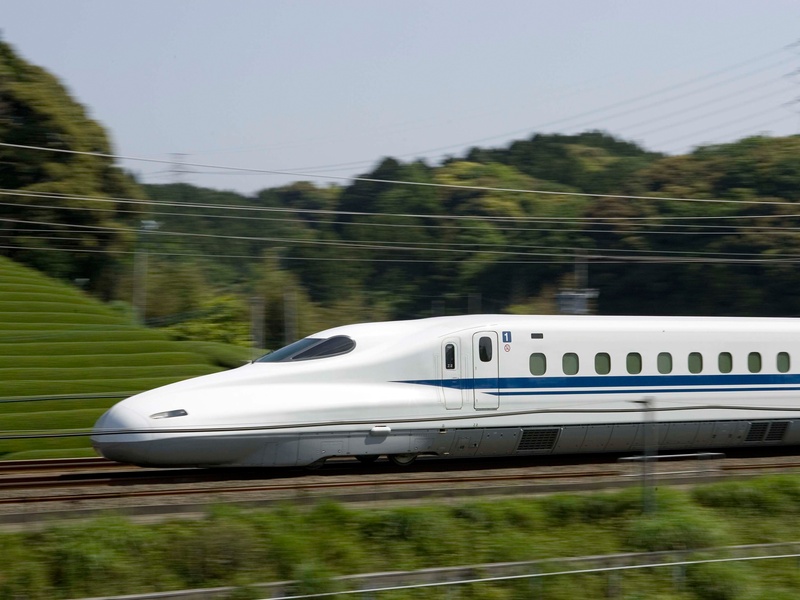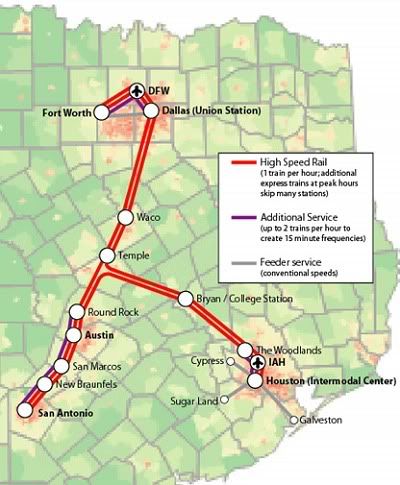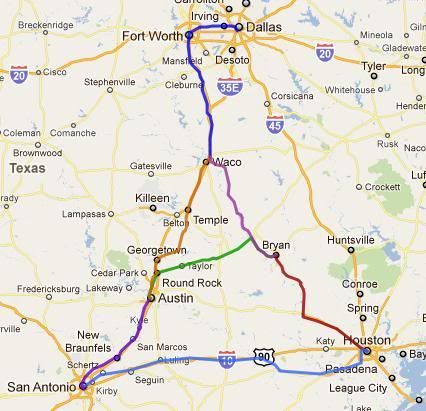(4 pm. – promoted by ek hornbeck)
 The Texas Department of Transport and Federal Railway Authority announced in June that they were beginning an Environmental Impact Study for the proposed private Texas Central Railways (TCR) High Speed Rail corridor between Houston and Dallas.
The Texas Department of Transport and Federal Railway Authority announced in June that they were beginning an Environmental Impact Study for the proposed private Texas Central Railways (TCR) High Speed Rail corridor between Houston and Dallas.
This is a private venture that is proposing to using the “Japan Rail Central” N700-I system, an internationalized version of the 186mph HSR train running between Tokyo and Osaka. TCR proposal is not only for the trains to be operated on farebox revenue, but for the corridor to be built with private funds. As the FRA announcement states:
TCR is a Texas-based company formed in 2009 to bring HSR to Texas as a private-sector venture. Working closely with Central Japan Railway Company (JRC), TCR is proposing the deployment of JRC’s N700-I Bullet System based on the world’s safest, most reliable, lowest emission, electric-powered, HSR systems, the Tokaido Shinkansen System. Developed and operated by JRC and the former Japan National Railways, the Tokaido Shinkansen has operated safely for almost 50 years and carries over 400,000 daily passengers. The most current generation Shinkansen train, the Series N700, runs at speeds up to 186 miles per hour.
Being a private venture, the EIS process will give us our first public look at corridor alternatives that TRC is considering, as well as the first opportunity for formal public comment.
A Private HSR Corridor
As the DallasNews reported (25 June, 2014):
As expected, the Federal Railroad Administration has given the thumbs-up to an environmental impact statement concerning a long-proposed Dallas-to-Houston high-speed rail line. The FRA, in conjunction with the Texas Department of Transportation, will conduct the EIS on behalf of the privately operated Texas Central Railway, which promises a 90-minute trek from Dallas to Houston (by 2021, give or take).
The EIS will study various route alignments, including “shared corridors with other existing linear infrastructure corridors such as railroads, roads, and electric utility lines.” Also, says the FRA, it will “analyze the potential impacts of stations, power facilities, and maintenance facilities to support HSR operations.” The review could take some time – several months, say transportation officials, and possibly longer than a year.
It will be interesting to see how this venture proceeds. It would seem that if a Private Express HSR corridor is going to succeed anywhere, it would be on the Houston to Dallas corridor. Unlike the task of connecting the LA Basin to the Bay Area in California, there are no big mountains in the way, which will cut the construction costs dramatically.
Also, at current N700 speeds, Dallas to Houston would be under two hours, and on their planned 205mph speeds, the trip should take about 90 minutes. According to international experience, while a train trip of 3hrs will typically capture 40% of the combined air/rail travel market, a train trip of 2hrs will typically capture 70% of that market.
Now, in many parts of the United States if there was a corridor that was such a no-brainer for an HSR service, it would already have an established publicly supported rail service with work in place to upgrade the speed of the service. But this is Texas we are talking about here.
Indeed, as trainweb recounts, back in the 90’s there was an effort to establish a HSR system in the “Texas Triangle” between Houston, Dallas, and San Antonio:
The Texas High Speed Rail Authority awared a fifty-year high speed rail franchise to the Texas TGV Corporation on 28 May 1991. Texas TGV was a consortium made up of Morrison Knudsen (USA), Bombardier (Canada), GEC-Alsthom (France/UK, builder of the TGV) and a group of financial institutions comprising Crédit Lyonnais, Banque IndoSuez, Merril Lynch, and others. Texas TGV won the franchise after over two years of litigation opposing it to a rival consortium backing German ICE technology. The franchise covered the design, construction, ownership and operation of the high speed rail system.
Texas TGV agreed to secure funding for the project entirely from private sources, since the state of Texas did not allow the use of state money. The project, with an original estimated cost of 5.6 billion dollars, got off to a rocky start. The first job was to conduct an environmental impact study, for the sum of 170 million dollars. The money proved difficult to assemble, and Texas TGV was granted a one-year extension by the Texas High Speed Rail Authority. This extension expired on 31 December 1993, and in the last few weeks leading up to it there was a mad scramble to secure the money. …
In August of 1994, the state of Texas decided that the Texas TGV Corporation had failed to live up to its promises, and withdrew the 50-year franchise for high speed rail development. By this time, the consortium had invested about 40 million dollars.
… so with TRC obtaining the financing to proceed with the EIS, they have cleared the hurdle where the original 1990’s effort to establish a private HSR network in Texas fell apart.
TRC is at present not discussing extensions beyond the Dallas / Houston corridor, but the Star Telegram on 25 June, 2014 noted:
Officials in North Texas have proposed finding a separate funding source to expand the line from Dallas to Fort Worth, a project that is expected to be the source of a separate review by the Federal Railroad Administration.
This is unsurprising, since apart from the rugged terrain separating the San Joaquin Valley from the LA Basin and the Bay Area, the other big cost-driver in the California HSR project are corridors through urban areas … so leaving the Dallas to Fort Worth leg as “somebody else’s job” is an effective strategy for cutting down total construction cost.
What About the Texas T-Bone?
 Where does the TRC Houston/Dallas project leave the so-called “Texas T-bone”? The Texas T-Bone proposed constructing a corridor from Dallas to San Antonio, including the three college towns of Waco, Temple, and the state capital Austin. It then proposes to slice a big chunk off of the total track required for a full Texas Triangle by running trains from Houston to a midpoint between Austin and Waco, allowing connections from Houston to all points north and south of the junction.
Where does the TRC Houston/Dallas project leave the so-called “Texas T-bone”? The Texas T-Bone proposed constructing a corridor from Dallas to San Antonio, including the three college towns of Waco, Temple, and the state capital Austin. It then proposes to slice a big chunk off of the total track required for a full Texas Triangle by running trains from Houston to a midpoint between Austin and Waco, allowing connections from Houston to all points north and south of the junction.
With the mayors of Houston, Dallas and Fort Worth throwing their support behind the TRC this last March, the Texas T-bone seems to have gone onto the back burner. The original Texas T-Bone proposal called for a service from Houston to Killeen, Texas, to connect to Fort Hood, with a transfer required to complete a trip from Houston to Waco, Forth Worth and Dallas to the north and to Austin and San Antonio to the south.
Alternative alignments along the same general principle involve a “mini-triangle”, or “Texas Wishbone” alignment, where a more direct alignment between College Station and Waco, and between College Station and Austin creates a possible “mini-triangle” of Austin / Waco / College Station with single legs stretching out, Waco / DFW, College Station / Houston, and Austin / San Antonio.
 A private Houston / Dallas HSR corridor would remove a substantial part of the transport demand on the College Station / Waco leg of the mini-triangle. However, the case for a Fort Worth / Austin / San Antonio corridor remains intact … and, if anything, strengthened by connections that might be provided from Fort Worth through to Dallas via the DFW Airport in support of the Houston / Dallas HSR corridor.
A private Houston / Dallas HSR corridor would remove a substantial part of the transport demand on the College Station / Waco leg of the mini-triangle. However, the case for a Fort Worth / Austin / San Antonio corridor remains intact … and, if anything, strengthened by connections that might be provided from Fort Worth through to Dallas via the DFW Airport in support of the Houston / Dallas HSR corridor.
The 90 minute Houston/Dallas trip would therefore tilt the balance toward a “Texas Wishbone” system consisting of San Antonio to Austin, with one branch of the Wishbone running Temple/Waco/Fort Worth (the north/south orange and blue segments in the map) and the other branch running College Station / Houston (the east/west green and red segments in the map).
With a 90min Houston / Dallas trip in place, Houston / Waco trips can be made via the Fort Worth / Waco section of a Fort Worth / San Antonio corridor. However, attracting trips from Houston to Austin or San Antonio via Dallas / Fort Worth seems much less likely, so substantial demand would remain for the Houston / College Station / Austin / San Antonio corridor. At the same time, a 90min Dallas / Houston trip would imply additional demand on the Houston / College Station leg for Fort Worth / Dallas to College Station via a transfer in Houston.
How Many Stations Will Dallas / Houston HSR have?
 The question of station placement is one where TCR, as a private venture, can be cagey until we are further into the EIS process. They say, on their web site:
The question of station placement is one where TCR, as a private venture, can be cagey until we are further into the EIS process. They say, on their web site:
Pending environmental reviews, Texas Central Railway anticipates stations in Dallas and Houston that will provide easy access to each region’s excellent highways, thoroughfares and expansive public transit network.
It would not be surprising if the main Dallas / Houston corridor had two to four stations: with each end having either a single station connecting to existing public transport links to downtown at an Interstate accessible location, or a downtown station and an outer suburban station, and with no intermediate stations at all. Development of a connecting intercity through corridor from Dallas to Fort Worth could add another two, one at or connecting to the Dallas / Fort Worth airport and the other for Fort Worth.
We will find out as part of the EIS process whether TCR is looking to a Dallas Union Station terminus, but that would connect with both the TRE and with the daily Amtrak Texas Eagle. With the liquidation of the Houston Intermodal Transport Center project, it is unclear where the terminal station might be located in Houston. However, wherever it is located is likely to become the de facto Intermodal Transport center for Houston, so accessibility to both Houston’s Light Rail network and to the Amtrak corridor east to New Orleans is hopefully an issue that will be raised as part of the public comment part of the Environmental Impact Study.
Conclusions and Conversations
This project would seem to have a reasonable chance to go ahead. This project is less prone to sabotage by anti-rail forces than many of the publicly funded projects that the Sunday Train has considered, which is especially critical in Texas, where not only is there a strong base of support for anti-rail positions, but the extreme gerrymander gives anti-rail forces gives that base of support power out of proportion to its numbers. At the same time, the terrain, the travel distance, and the substantial demand for intercity trips between Houston and Dallas make this one of the best performing corridors on a private as well as public benefit/cost ratio basis.
But the Sunday Train does not finish with the end of the essay … that is just the prelude to the conversation. So feel free to introduce any issue involving sustainable energy and transport into the mix. And I would be especially pleased if you could share where it is that you would like to see an Express HSR corridor (that is, top speed of 150mph through 220mph) get started sometime in the second half of this decade?

4 comments
Skip to comment form
Author
We don’t get a lot of that even if it has to be privately funded which does give less opposition in this red gerrymandered state I reside in though I want a public nation wide STRACNET. Maybe this will bridge the divide our cities have — we don’t like each other very much. Regardless, we will see what happens.
Thanks, BruceMcF!
Nice to know somebody’s doing something right in that state